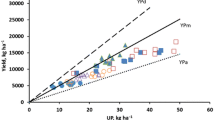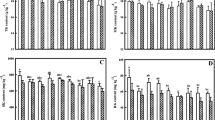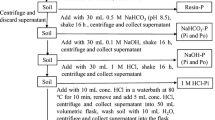Abstract
Market opportunities will drive intensification of cassava production and fertilizer will play a role in this. A trial was initiated on 15 farmers ’ fields (replications) in one village territory in Benin on a relatively fertile sedimentary soil site to identify nutrients limiting cassava yield using nutrient omission plots over three cropping years. There was no response to fertilizer in the first year when fresh root yields in the unamended control averaged 19.1 t ha−1. In the second year, the control yield was 16 t ha−1 and there were significant reductions from withholding P (3.5 t ha−1) and K (2 t ha−1) from a complete fertilizer regime. Nutrient balance after 1 and 2 years (cumulative) showed substantial P and K deficits in unamended plots. In the third year, the control yield was 12.9 t ha−1 and effects of withholding K (5.3 t ha−1), P (5.0 t ha−1) and N (3.0 t ha−1) were statistically significant. Soil K was a significant source of variation in yield in the third year. In the third year of annual nutrient additions soil P and K in the top 0.3 m were increased by 37 and 40%, respectively. Based on the cumulative nutrient balance calculation, the annual application needed to compensate nutrient depletion was 13 kg N, 10 kg P, and 60 kg K ha−1. Partial budget analysis based on these amounts of fertilizer suggested that investment was clearly justified in the third year of continuous cropping at current low cassava prices.
Similar content being viewed by others
References
B.P. Agbo (1999) Restoring Crop Productivity in West Africa: The Potential of Agroforestry Margraf Verlag Weikersheim Germany
T.P. Akondé R.F. Kühne N. Steinmüller D.E. Leihner (1997) ArticleTitleAlley cropping on an Ultisol in subhumid Benin. Part 3: Nutrient budget of maizecassava and trees Agrof. Syst. 37 213–226
S.J. Carr (2001) ArticleTitleChanges in African smallholder agriculture in the twentieth century and the challenges of the twenty-first Afr. Crop Sci. J. 9 331–338
R.J. Carsky (2003) ArticleTitleResponse of cowpea and soybean to P and K on terre de barre soils in southern Benin Agric. Ecosyst. Environ. 100 IssueID2/3 241–249 Occurrence Handle1:CAS:528:DC%2BD3sXpt1emu7w%3D
R.J. Carsky M.A. Toukourou (2004) ArticleTitleCassava leaf litter estimation in on-farm trials Exp. Agric. 40 315–326
InstitutionalAuthorNameCIMMYT (1988) From Agronomic Data to Farmer Recommendations: An Economics Training Manual. Completely revised edition CIMMYT MexicoDF 79
N. De Ridder H. van Keulen (1990) ArticleTitleSome aspects of the role of organic matter in sustainable intensified arable farming systems in the West-African semi-arid-tropics (SAT) Fertil. Res. 26 299–310
FAO/IFAD. 2001. The global cassava development strategy and implementation plan. Volume 1. Proceedings of the Validation Forum on the Global Cassava Development Strategy. Rome26–28 April, FAO/IFAD, Rome, Italy, 70pp.
FAOSTAT 2003. http://apps.fao.org/cgi-bin/nph-db.p1?subset=agriculture downloaded in April, 2003 for yield in West Africa.
A. Floquet R. Mongbo (1998) Des paysans en mal d ’alternatives: dégradation des terres, restructuration de 1’espace agraire et urbanisation au bas-Bénin Margraf Verlag WeikersheimGermany 190
Hermann L. 1996. Staubdeposition auf Böden West-Afrikas–Eigenschaften und Herkunftsgebiete der Stäube und ihr Einfluß auf Böden- und Standortseigenschaften. Hohenheimer Bodenkundliche Hefte. Heft 36. Diss. University of HohenheimGermany, 176 pp.
Hinvi J.C.. 1992. Contribution dés paysans de Département de 1 ’Atlantique (Bénin) á la resolution du probléme de baisse de fertilité des sols. In: Seminaire National sur la Recherche-Developpement au Benin: Acquis et Perspectives, Cotonou. 3 to 7 December 1990, pp. 41-52.
R.H. Howeler (1981) The mineral nutrition and fertilization of cassava (Manihot esculenta Crantz) Centre Internacional de Agricultura Tropical CaliColombia 52
R.H. Howeler (1985) Potassium nutrition of Cassava R.D. Munson (Eds) Potassium in Agriculture. Proc. Int. SymposiumAtlantaGAUSA7–10 July 1985 American Society of Agronomy Madison, WI, USA 819–841
R.H. Howeler (2002) Cassava mineral nutrition and fertilization R.J. Hillocks J.M. Thresh A.C. Belloti (Eds) Cassava: Biology, Production and Utilization CAB International WallingfordUK 115–147
R.H. Howeler L.F. Cadavid (1983) ArticleTitleAccumulation and distribution of dry matter and nutrients during a 12-month growth cycle of cassava Field Crops Res. 7 123–139
InstitutionalAuthorNameINRAB (Institut National de Recherches Agricoles du Benin) (1995) Fiche technique. Cultures vivriéres. Cereales, legumineuses à graines et tubercules INRABCotonou Republique du Bénin 75
INRAB (Institut National des Recherches Agricoles du Bénin) 1997. Caractérisation de la zone de la savane numide coôtiére/dérivée du Bénin. Programme Eco-Regional pour les tropiques humides et subhumides de 1 ’Afhque au Sud du Sahara (EPHTA). INRABCotonouBénin.
InstitutionalAuthorNameIITA (1979) Selected Methods for Soil and Plant Analysis IITA Ibadan, Nigeria
IITA 2001. Annual report of IITA project on “Cassava productivity in lowland and midaltitude agroecologies of sub-Saharan Africa” available at http://www.iita.org/research/cassprod 1.htm.
P.A. Jomini R.R. Deuson J.J. Lowenbeerg-DeBoer A. Bationo (1991) ArticleTitleModelling stochastic crop response to fertilisation when carry-over matters Agric. Econ. 6 97–113
B.T. Kang (1984) ArticleTitlePotassium and magnesium responses of cassava grown in Ultisol in southern Nigeria Fertil. Res. 5 403–410 Occurrence Handle1:CAS:528:DyaL2cXmtV2rur4%3D
D. Leihner (2002) Agronomy and cropping systems R.J. Hillocks J.M. Thresh A.C. Belloti (Eds) Cassava: Biology, Production and Utilization CAB International WallingfordUK 91–113
L. Norgrove S. Hauser S.F. Weise (2000) ArticleTitleResponse of Chromolaena odorata to timber tree densities in an agrisilvicultural system in Cameroon: aboveground biomass, residue decomposition and nutrient release Agric. Ecosyst. Environ. 81 191–207
F. Nweke (1996) Cassava: A cash crop in Africa. Collaborative Study of Cassava in Africa (COSCA) Working paper No. 14 IITA Ibadan, Nigeria
F.I. Nweke D.S.C. Spencer (1995) ArticleTitleFuture prospects for cassava root yield in sub-Saharan Africa Outlook Agric. 24 35–42
F.I. Nweke D.S.C. Spencer J.I. Lynam (2002) Cassava Transformation: Africa’s Best-kept Secret Michigan State University Press East Lansing, MI, USA
R. Poss J.C. Fardeau H. Saragoni (1997) ArticleTitleSustainable agriculture in the tropics: the case of potassium under maize cropping in Togo Nutr. Cycl. Agroecosyst. 46 205–213
M. Raunet (1977) Caractérisation du milieu physique des points d’expérimentation agronomique Rapport IRAT/PNUD, INRAB (ex. DRA) CotonouBenin
H. Saragoni R. Poss J. Marquette E. Latrille (1992) ArticleTitleFertilisation et sucession des cultures vivriéres au sud du Togo: synthése d’une experimentation de longue durée sur terres de barre L’Agronomie Tropicale 46 107–120
InstitutionalAuthorNameSAS Institute Inc. (1985) SAS User’s Guide: Statistics SAS Institute Cary, NC, USA
K. Stahr K.E. Bleich U. Weller (1996) Land evaluation and land use planning in southern Benin – suitability of the region for traditional and innovative production systems Adapted Farming in West Africa. Interim report 1994–1996 for Special Research Programme 308 University of Hohenheim StuttgartGermany 85–111
InstitutionalAuthorNameUniversité Nationale du Bénin (1992) Le Benin en Chiffres. Edition 1992 Department Economic et Sociologie Rurales, Faculté de Sciences Agronomiques, Université Nationale du Bénin CotonouBenin 88
F. Pol ParticleVan der A.C. Gogan G. Dagbenobakin (1993) L’Epuisement des Sols et sa Valeur Economique dans le Departement du MonoBenin INRAB RAMR project CotonouBenin 80
Werts R. 1979. Dossier pour une synthèse des résultants de la recherché agronomique au Benin en maïsiculture. Unpublished mimeograph for the Institut de Recherches Agronomiques Tropicales et des Cultures Vivriéres, France and the Direction de la Recherche Scientifique et TechniqueDepartement de la Recherche AgronomiqueBenin.
A. Wild (1971) ArticleTitleThe potassium status of soils in the savanna zone of Nigeria Exp. Agric. 7 257–270 Occurrence Handle10.1017/S001447970000034X Occurrence Handle1:CAS:528:DyaE3MXkslGgur8%3D
Author information
Authors and Affiliations
Corresponding author
Rights and permissions
About this article
Cite this article
Carsky, R.J., Toukourou, M.A. Identification of nutrients limiting cassava yield maintenance on a sedimentary soil in southern Benin, West Africa. Nutr Cycl Agroecosyst 71, 151–162 (2005). https://doi.org/10.1007/s10705-004-1803-9
Received:
Accepted:
Issue Date:
DOI: https://doi.org/10.1007/s10705-004-1803-9




